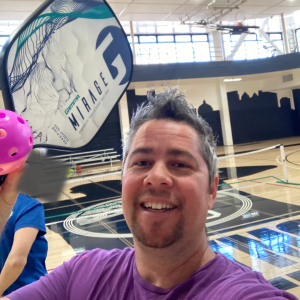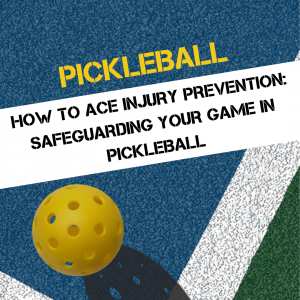
Prevalence of Pickleball Injuries:
Pickleball, a rapidly growing sport, has gained popularity across all age groups. However, with increased participation comes a higher incidence of injuries. Players may encounter various injuries due to the dynamic nature of the game, ranging from falls and fractures to strains and tendinopathies. Using data collected from NEISS, the most recent numbers show an estimated 19,012 pickleball related injuries per year.
What Are the Most Common Pickleball Injuries
Falls & fractures
The quick movements and sudden changes in direction in pickleball can sometimes lead to falls, resulting in fractures or head trauma.
Sprains/strains
Ankle sprains, knee strains, and hamstring strains are prevalent in pickleball due to the rapid shifts in movement and quick stops on the court.
Strains occur anytime a muscle in our body is overstretched. Strains range from a mild pull on the muscle to complete tearing, and are classified in 3 different grades:
- Grade I: mild strain that causes tenderness and pain but results in no significant impairments (full range of motion and no loss of strength). The general recovery time frame is 2-4 weeks.
- Grade II: a grade II strain results in moderate impairment, marked pain and tenderness, decreased range of motion at the joints involved with the strained muscle, and a noticeable loss of strength secondary to pain. The general recovery time frame is 4-8 weeks.
- Grade III: a grade III strain results in immediate pain at the time of the injury with possible audible “pop” at the time of injury, possible palpable defect in the muscle surrounded by swelling (edema), with complete rupture of the muscle structure. The general recovery time frame is 8-16 weeks
Sprains occur when a ligament is overstretched. These injuries usually occur when one of our joints moves in an aberrant way beyond the available joint range of motion (such as rolling your ankle or twisting your knee). As with strains, sprains are also categorized into grades based on the severity:
- Grade 1 Sprain (Mild): Slight stretching and microscopic tearing of the ligament fibers. Mild tenderness and swelling around the joint. The general recovery time frame is 2-3 weeks.
- Grade 2 Sprain (Moderate): Partial tearing of the ligament occurs. There is moderate tenderness and swelling around the joint, and some instability may be noticed during physical examination. The general recovery time frame is 4-8 weeks.
- Grade 3 Sprain (Severe): Complete tear of the ligament, with significant tenderness and swelling around the joint. There can be audible popping at the time of the injury, and instability can be noted during physical examination. The general recovery time frame is 8-16 weeks.
Shoulder Pickleball Injuries
Frequent overhead smashes can predispose players to shoulder injuries, including rotator cuff tears and tendinitis.
Knee Pickleball Injuries
Lateral movements and sudden stops can stress the knee joints, leading to strains, meniscus tears, and other knee-related injuries.
Hip Pickleball Injuries
Hip injuries may occur due to the repetitive nature of the game and the strain placed on the hip joints during movements.
Foot and Ankle Pickleball Injuries
The constant movement and pivoting on the court can put stress on the feet and ankles, resulting in sprains, strains, or plantar fasciitis.
Elbow and wrist tendinopathy
Repeated gripping and swinging motions can cause tendinopathies in the elbow and wrist, such as tennis elbow or wrist tendinitis. Tendinitis is an acute injury mediated by inflammation, but when it becomes chronic (months to years), it may develop into tendinosis, which is more of a degenerative problem and requires more comprehensive treatment. It’s important to understand the difference between tendinitis and tendinosis.
How sports chiropractic can prevent injuries in pickleball
Individualized assessments
Sports chiropractors can conduct thorough assessments to identify bio-mechanical imbalances, weaknesses, and areas of vulnerability in players.
Education on pickleball injury prevention
Chiropractors educate players on proper warm-up routines, technique improvement, and strategies to prevent common injuries.
Joint mobilizations
Chiropractic adjustments and joint mobilizations help improve joint function, reduce stiffness, and enhance overall mobility, reducing injury risk.
Manual therapy
Chiropractors utilize manual therapy techniques to address soft tissue restrictions, muscle imbalances, and alignment issues that may contribute to injury.
Corrective physiotherapy exercises
Chiropractors prescribe tailored exercise programs to strengthen muscles, improve flexibility, and correct movement patterns, preventing injuries and enhancing performance.
How to prevent pickleball injuries on the court
Proper warmup
Players should engage in dynamic warm-up exercises to prepare their bodies for the demands of pickleball, focusing on mobility, flexibility, and activation of key muscle groups.
Stretch after
After playing, players should incorporate static stretching to maintain flexibility, reduce muscle tension, and promote recovery.
Tend to injuries using PEACE and LOVE not RICE
In the event of an injury, players should follow the PEACE and LOVE approach, which emphasizes protection, elevation, avoiding anti-inflammatories, compression, and education, rather than the traditional RICE (Rest, Ice, Compression, Elevation) method.
Pickleball injury treatment best practices
Get evaluated at first sign of pain – don’t let injuries linger
Early evaluation and treatment of injuries are crucial to prevent them from worsening and affecting long-term performance. Players should seek professional evaluation at the first sign of pain or discomfort.
Chiropractic adjustments
Chiropractic adjustments can help restore proper joint alignment, alleviate pain, and promote healing by optimizing nervous system function.
Manual therapy
Hands-on techniques such as soft tissue massage and myofascial release can address muscle tightness, trigger points, and adhesions, facilitating recovery and reducing the risk of re-injury.
Strengthen and stabilize with home PT exercises
Players should adhere to a home exercise program prescribed by a physical therapist or chiropractor to strengthen weak muscles, improve stability, and prevent future injuries. Consistency and adherence to the exercise regimen are key to achieving optimal outcomes.
In conclusion, preventing and treating pickleball injuries requires a multifaceted approach involving proper preparation, education, evaluation, and targeted interventions. By implementing preventive strategies, seeking timely treatment, and following rehabilitation protocols, players can minimize injury risks and enjoy the game safely and sustainably.
Coming June 2024…..a home exercise guide to preventing common pickleball injuries….. STAY TUNED

